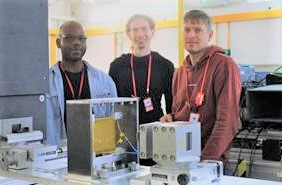Polarised neutrons to study magnetic materials
Magnetic materials are investigated at IMAT
IMAT (Imaging and Materials Science & Engineering) is a neutron imaging and diffraction instrument for materials science and engineering, located at the ISIS Neutron and Muon Source in Oxfordshire, UK..
For the first time, polarised neutrons have been used at IMAT to study 3D printed magnets. This is thanks to a collaboration between ISIS, Uppsala University, Helmholtz-Zentrum Berlin (HZB), Institut Laue-Langevin (ILL) and the European Spallation Source (ESS).
The magnets used today in many "green" technologies (such as electric vehicles and wind turbines), are made from rare earth metals such as neodymium and dysprosium, which are expensive and create a lot of waste and mining problems.
Professor Martin Sahlberg from Uppsala University is looking at how additive manufacturing can be used to manufacture magnets that are made from other materials that are cheaper and have a lower environmental impact. In order to design the magnets in a way that makes them useful for different applications, it is important to understand how the 3D printing process affects the internal structure and magnetic properties.
Using crystallography, it is possible to examine the orientation of the crystals, but further studies are needed to look at the resulting magnetic arrangement. Polarised neutrons can be used to study magnetic fields but have never been used on the IMAT beamline at ISIS before.
Using knowledge from other European facilities, and the neutron team at ISIS, this technique has been used for the first time to image magnetic fields around known magnetic samples, as well as some new magnets produced by Martin Sahlberg.
The work was done together with Dr. Nikolay Kardjilov from the Helmholtz-Zentrum Berlin (HZB), Mr. Ugwumsinachi Oji from the Institut Laue-Langevin (ILL) and Dr. Robin Woracek and Dr. Alexander Backs from the European Spallation Source (ESS).
Contact: Martin Sahlberg

Ugwumsinachi Oji, Institut Laue-Langevin (ILL),Alexander Backs, European Spallation Source(ESS) och Martin Sahlberg, Uppsala universitet.
Contact
- If you have questions about our research, you are welcome to contact the programme professor Professor Martin Sahlberg.
- Martin Sahlberg
